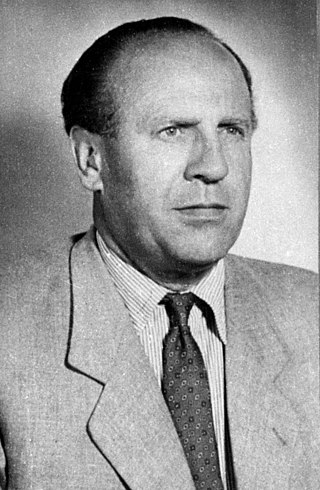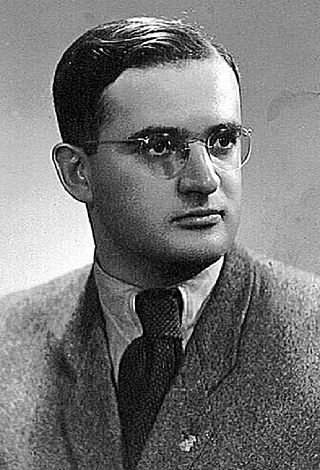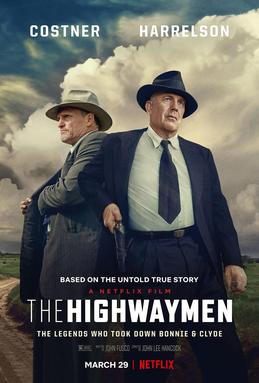Related Research Articles

Oskar Schindler was a German industrialist, humanitarian, and member of the Nazi Party who is credited with saving the lives of 1,200 Jews during the Holocaust by employing them in his enamelware and ammunitions factories in occupied Poland and the Protectorate of Bohemia and Moravia. He is the subject of the 1982 novel Schindler's Ark and its 1993 film adaptation, Schindler's List, which reflected his life as an opportunist initially motivated by profit who came to show extraordinary initiative, tenacity, courage, and dedication in saving his Jewish employees' lives.

Schindler's List is a 1993 American epic historical drama film directed and produced by Steven Spielberg and written by Steven Zaillian. It is based on the 1982 novel Schindler's Ark by Australian novelist Thomas Keneally. The film follows Oskar Schindler, a German industrialist who saved more than a thousand mostly Polish–Jewish refugees from the Holocaust by employing them in his factories during World War II. It stars Liam Neeson as Schindler, Ralph Fiennes as SS officer Amon Göth, and Ben Kingsley as Schindler's Jewish accountant Itzhak Stern.

Bonnie Elizabeth Parker and Clyde Chestnut "Champion" Barrow were American bandits and serial murderers who traveled the Central United States with their gang during the Great Depression. The couple was known for their bank robberies and multiple murders, although they preferred to rob small stores or rural funeral homes. Their exploits captured the attention of the American press and its readership during what is occasionally referred to as the "public enemy era" between 1931 and 1934. They were ambushed by police and shot to death in Bienville Parish, Louisiana. They are believed to have murdered at least nine police officers and four civilians.

Bonnie and Clyde is a 1967 American biographical neo-noir crime film directed by Arthur Penn and starring Warren Beatty and Faye Dunaway as the title characters Clyde Barrow and Bonnie Parker. The film also features Michael J. Pollard, Gene Hackman, and Estelle Parsons. The screenplay is by David Newman and Robert Benton. Robert Towne and Beatty provided uncredited contributions to the script; Beatty produced the film. The music is by Charles Strouse.

Apollo 13 is a 1995 American docudrama film directed by Ron Howard and starring Tom Hanks, Kevin Bacon, Bill Paxton, Gary Sinise, Ed Harris and Kathleen Quinlan. The screenplay by William Broyles Jr. and Al Reinert dramatizes the aborted 1970 Apollo 13 lunar mission and is an adaptation of the 1994 book Lost Moon: The Perilous Voyage of Apollo 13, by astronaut Jim Lovell and Jeffrey Kluger.

Michael J. Pollard was an American actor. He is best known for his role as C.W. Moss in the film Bonnie and Clyde (1967), which earned him critical acclaim along with nominations for an Academy Award, a British Academy Film Award, and two Golden Globe Awards.

Catch Me If You Can is a 2002 American biographical crime comedy-drama film directed and produced by Steven Spielberg and starring Leonardo DiCaprio and Tom Hanks with Christopher Walken, Martin Sheen, Nathalie Baye, Amy Adams, and James Brolin in supporting roles. The screenplay by Jeff Nathanson is based on the semi-autobiographical book of the same name by Frank Abagnale Jr., who claims that prior to his 19th birthday, he successfully performed cons worth millions of dollars by posing as a Pan American World Airways pilot, a Georgia doctor, and a Louisiana parish prosecutor. The truth of his story is heavily disputed.

Frank William Abagnale Jr. is an American security consultant, author, and convicted felon who committed frauds that mainly targeted individuals and small businesses. He later gained notoriety in the late 1970s by claiming a diverse range of workplace frauds, many of which have since been placed in doubt. In 1980, Abagnale co-wrote his autobiography, Catch Me If You Can, which built a narrative around these claimed frauds. The book inspired the film of the same name directed by Steven Spielberg in 2002, in which Abagnale was portrayed by Leonardo DiCaprio. He has also written four other books. Abagnale runs Abagnale and Associates, a consulting firm.

The Schindlerjuden, literally translated from German as "Schindler Jews", were a group of roughly 1,200 Jews saved by Oskar Schindler during the Holocaust. They survived the years of the Nazi regime primarily through the intervention of Schindler, who afforded them protected status as industrial workers at his enamelware factory in Kraków, capital of the General Government, and after 1944, in an armaments factory in occupied Czechoslovakia. There, they avoided being sent to death camps and survived the genocide. Schindler expended his personal fortune made as an industrialist to save the Schindlerjuden.
Itzhak Stern was a Polish-Israeli Jewish Holocaust survivor who worked for Sudeten-German industrialist Oskar Schindler and assisted him in his rescue activities during the Holocaust.

Francis Augustus Hamer was an American lawman and Texas Ranger who led the 1934 posse that tracked down and killed criminals Bonnie Parker and Clyde Barrow. Renowned for his toughness, marksmanship, and investigative skill, he acquired status in the Southwest as the archetypal Texas Ranger. He was inducted into the Texas Ranger Hall of Fame. His professional record and reputation are controversial, particularly with regard to his willingness to use extrajudicial killing even in an increasingly modernized society.

William Daniel Jones was a member of the Barrow Gang, whose crime spree throughout the southern Midwest in the early years of the Great Depression became part of American criminal folklore. Jones ran with Clyde Barrow and Bonnie Parker for eight and a half months, from Christmas Eve 1932 to early September 1933. He and another gang member named Henry Methvin were consolidated into the "C.W. Moss" character in the film Bonnie and Clyde (1967). Of the character C.W. Moss in the movie, Jones said: "Moss was a dumb kid who run errands and done what Clyde told him. That was me, all right."

Ted Cass Hinton was a Dallas County, Texas, deputy sheriff, the youngest of the posse that ambushed and killed Bonnie and Clyde near Gibsland, Louisiana, on May 23, 1934.
The Barrow Gang was an American gang active between 1932 and 1934. They were well known outlaws, robbers, murderers, and criminals who, as a gang, traveled the Central United States during the Great Depression. Their exploits were known all over the nation. They captured the attention of the American press and its readership during what is sometimes referred to as the 'public enemy era'. Though the gang was notorious for the bank robberies they committed, they preferred to rob small stores or gas stations over banks. The gang was believed to have killed at least nine police officers, among several other murders.

Henry Methvin was an American criminal, a bank robber, and a Depression-era outlaw. He is best remembered as the final member of Bonnie and Clyde's gang. His role in the gang has often been misattributed to teenage gang member W.D. Jones as both men were portrayed as composite character "C.W. Moss" in the film Bonnie and Clyde (1967).

Mieczysław "Mietek" Pemper was a Polish-born German Holocaust survivor. Pemper helped compile and type Oskar Schindler's now-famous list, which saved 1,200 people from being killed in the Holocaust during World War II.

Rob the Mob is a 2014 American romantic crime film directed by Raymond De Felitta and written by Jonathan Fernandez. The film stars Michael Pitt, Nina Arianda, Andy García, Ray Romano, Aida Turturro, Frank Whaley, Michael Rispoli and Joseph R. Gannascoli, and is based on a true story. It was released on March 21, 2014.

Bonnie & Clyde is a revisionist 2013 miniseries about Great Depression-era outlaws Bonnie Parker and Clyde Barrow starring Emile Hirsch as Clyde Barrow and Holliday Grainger as Bonnie Parker. The two-part series aired on consecutive nights, December 8 and 9, 2013, simultaneously on A&E, History, and Lifetime. The first previews were released on September 23, 2013. The series was widely criticized for its historical inaccuracies, particularly as it was aired on History.
Abraham Bankier was a Polish businessman and Holocaust survivor who assisted Oskar Schindler in his rescue activities and worked as his factory manager.

The Highwaymen is a 2019 American period crime thriller film directed by John Lee Hancock and written by John Fusco. The film stars Kevin Costner and Woody Harrelson as Frank Hamer and Maney Gault, two former Texas Rangers who attempt to track down and apprehend notorious criminals Bonnie and Clyde in the 1930s. Kathy Bates, John Carroll Lynch, Kim Dickens, Thomas Mann and William Sadler also star.
References
- ↑ Gutkind, Lee; Fletcher, Hattie (2008). Keep It Real: Everything You Need to Know About Researching and Writing Creative Nonfiction (1st ed.). New York: W.W. Norton. p. 39. ISBN 978-0393065619.
- ↑ Kaufman, Michael T. (13 August 1999). "John D. Lewis, 84, Pilot in 'The Great Escape'". The New York Times . Retrieved 15 March 2015.
- ↑ Bishop, Patrick (30 August 2015). "William Ash: The cooler king". BBC Online . Retrieved 30 August 2015.
- ↑ Foley, Brendan (29 April 2014). "Bill Ash obituary". The Guardian . London . Retrieved 30 August 2015.
- ↑ "William Ash - obituary". The Daily Telegraph . London. 30 April 2014. Retrieved 30 August 2015.
- ↑ "Riding with Bonnie & Clyde". Playboy Magazine . November 1968.
That C. W. Moss in the movie was me, up to the end, when he let his old man turn in Clyde and Bonnie.. It was Henry Methvin that done that, not me I was in jail when that happened. The papers was right when they said Moss was a composite of me and Methvin.
- ↑ "Death Comes in the Sun: Trading one life for two; mistrust". BabyFace Nelson ~ Journal. 21 July 2008. Retrieved 2 September 2023.
After months of constant tracking, Hamer was finally ready to make his move. For some time, he had been meeting with Methvin's family, which was trying to broker a deal that would not only keep Methvin out of the electric chair, but possibly even out of prison. In exchange, they would hand over Barrow and Parker.
- ↑ Sartore, Melissa (29 September 2022). "12 Figures From Historical Movies Who Are Actually Composites Of Multiple People". Ranker . Retrieved 2 September 2023.
While there was a real Stern, and he did work with Schindler, the movie character represented the collective activities of no fewer than four men.
- ↑ Lovell, Jim; Kluger, Jeffrey (1994). Apollo 13 . New York City: Pocket Books. pp. 118, 209–210, 387. ISBN 0671534645.
- ↑ Pagnotti, Sean (28 February 2023). "Catch Me if You Can: The "True" Story of Frank Abignale Jr. Explained". Collider . Retrieved 3 September 2023.
Speaking of the FBI, Carl Hanratty is actually a composite of several agents who were assigned Frank's case, the main one being Joe Shea. Joe has since passed on but didn't want his name used in the movie when he was alive.
- ↑ "House of Cards". Boston.com . 6 April 2008. Retrieved 13 October 2013.(subscription required)
- ↑ Thapa, Shaurya (14 May 2023). "Dallas Buyers Club True Story: 7 Things The Movie Changed From Real-Life". Screen Rant . Retrieved 3 September 2023.
[Ravon] was supposed to represent the judgmental behavior and stereotypical assumptions that many trans people living with AIDS faced during that time.…\\….Saks also bears similarities with the late physician Dr. Linda Laubenstein, one of the first American doctors to spread awareness of the AIDS epidemic in the 1980s.
- ↑ Alexander, Bryan (20 July 2017). "Dunkirk: How historically accurate is Christopher Nolan's WWII battle film?". USA Today . Retrieved 22 January 2018.
- ↑ Bruemmer, René (2 August 2017). "Inspiration for summer blockbuster Dunkirk an unsung Montreal hero". Montreal Gazette . Retrieved 2 August 2017.
- ↑ "Unsung hero of Dunkirk evacuation a former McGill student". McGill Reporter. McGill University. 7 August 2017. Archived from the original on 4 September 2017. Retrieved 4 September 2017.
- ↑ "This war hero was forgotten in Canada and portrayed as a Brit in Dunkirk. Now he's finally getting his due". Washington Post. 21 September 2017.
- ↑ Broich, John (20 July 2017). "What's Fact and What's Fiction in Dunkirk". Slate . Archived from the original on 13 March 2018. Retrieved 25 March 2018.
- ↑ Epstein, Rachel (12 December 2019). "Spoiler Alert: Margot Robbie's Bombshell Character Isn't Real". Marie Claire . Retrieved 8 December 2020.
- ↑ "Emily Watson on her new TV drama, Chernobyl". The Scotsman . Retrieved 4 June 2019.
- ↑ Dicken, Frank (2014). Herod as a Composite Character in Luke-Acts. Tübingen, Germany: Mohr Siebeck. p. 7. ISBN 978-3161532542.
- ↑ "Ex-aide's Book Alleges Kennedy Used Drugs The Senator Called Allegations About Orgies, Drugs And Alcohol "Bizarre And Untrue"". The Inquirer. 27 September 1992. Archived from the original on 6 March 2016. Retrieved 25 October 2015.
- ↑ Isaak, Sharon (30 October 1992). "Tales of Ted Kennedy". Entertainment Weekly. Retrieved 25 October 2015.
- ↑ Shafer, Jack (12 June 2003). "The fabulous fabulists". Slate. Retrieved 13 October 2013.
- ↑ Carduff, Christopher (3 November 1992). "Fish-eating, whiskey, death & rebirth". New Criterion. Archived from the original on 6 March 2001. Retrieved 12 May 2016.
- 1 2 O'Rourke, Meghan (29 July 2003). "Literary license". Slate. Retrieved 13 October 2013.
- ↑ "Unethical writers love the power of creative non-fiction -". WTOP.com. 13 January 2006. Archived from the original on 26 September 2007. Retrieved 13 October 2013.